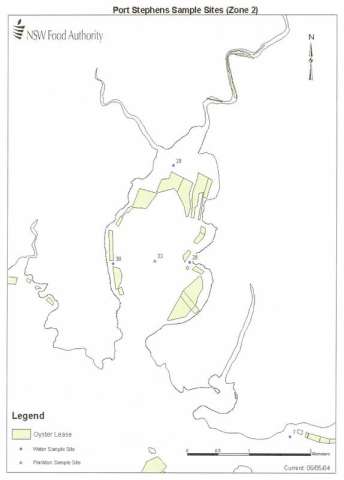The NSW Food Authority has sampled and tested the water quality in North Arm Cove since 2003 to determine whether it is safe to harvest oysters. When these results are compared to local rainfall data, an estimate can be made as to whether the water is safe for recreational activities
Testing is mainly carried out after adverse pollution events ie rainfall. There are 3 sampling points, one off Water Street, one near the mouth of Bulga Creek and one near Bundabah. On the western side of the Cove, there is a sampling site near Carrington. The results of the testing and the locations of the sample collection points are available on the Food Authority website.
One of the measures of water quality is faecal colliforms, which are an indicator of recent faecal waste from warm blooded animals and sewage. `Anzecc (2000) trigger values are as follows:
- Primary contact should not occur when the median bacterial content exceeds 150 faecal colliforms per 100ml eg swimming
- Secondary contact should not occur when the median bacterial content exceeds 1000 faecal colliforms per 100ml.
Generally the water quality is high and safe for all recreational activities. However, after heavy rain, the faecal colliforms levels rise to unsafe levels well above 1000fcu/100ml. If there has been heavy rain (over 100ml) over three or four days, it takes about six days for the faecal colliform levels to drop to about 30fcu/100ml. Normal levels of about 1fcu/100ml take up to a month to return in winter.
It is much harder to predict the effect of lighter rain of say 20 to 50ml over a couple of days. There are a lot of variables some of which include:
- whether earlier rain has already cleaned the system,
- whether the ground is already water logged (particularly a problem for older septic waste disposal systems)
- whether there are some king tides
- time of year.
So what does this all mean for swimming and other recreational activities. I think the best advice is to be cautious and follow Beachwatch recommendations of not swimming for 3 days after heavy rainfall. If the water is still brown after this amount of time, it would be wise to allow another couple of days.
If there has been lighter rain of say 20 to 50ml, you have to take an educated guess. If there has been good flushing rain in the previous couple of months, the water quality is probably OK if the ground is not water logged. However, if it is cold, or there has been a dry spell prior to the rain, I would treat the water quality as suspect for at least a couple of days.
We have been notified by the NSW Food Authority that there is a new initiative to monitor water quality in North Arm Cove. The project aims to determine:
- If faecal pollution in North Arm Cove is linked to rainfall events, and
- the relative contribution of human and non-human faecal matter to the total faecal load.
This initiative is a collaborative project involving the NSW Food Authority, Newcastle University and Great Lakes Council. The information will be used to provide an indication of the performance of on-site sewage management systems (septics) in the area. The study should also give us a better indication of when the water quality is likely to be safe for recreational activities.



